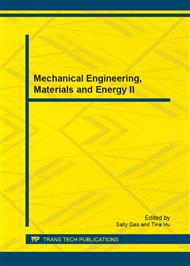[1]
Guo Lei, Xu You chun, Li Ke qiang, et al. Study on Real-Time Distance Detection Based on Monocular Vision Technique. Journal of Image and Graphics, 2006, 11(1): 74~81.
Google Scholar
[2]
Qu Yan cheng, Huang Heng jun, Wang Chang hong. Research on Vision-Based Localization Method of Mobile Robot Formation. Computer Engineering and Applications, 2005, 41(26): 66~68.
Google Scholar
[3]
Zhang Guang jun, Zhou Fu qiang. Position and Orientation Estimation Method for Landing of Unmanned Aerial Vehicle with Two Circle Based Computer Vision. Acta Aeronautica et Astronautica Sinica, 2005, 26 (3): 344 ~ 348.
Google Scholar
[4]
Liu Bing ru, Xie Yun, Yang Yi min, et al. A Self-Localization Method with Monocular Vision for Autonomous Soccer Robot. IEEE International Conference on Industrial Technology, 2005, 888~892.
DOI: 10.1109/icit.2005.1600761
Google Scholar
[5]
Omar Ait Aider, Philippe Hoppenot, Etienne Colle. A model-based method for indoor mobile robot localization using monocular vision and straight-line correspondences[J]. Robotics and Autonomous Systems, 2005, (52): 229-246.
DOI: 10.1016/j.robot.2005.03.002
Google Scholar
[6]
Rorer E, Lhuillier M. Monocular vision for mobile robot localization and autonomous navigation[J]. International Journal of Computer Vision, 2007, 74(3): 237-260.
DOI: 10.1007/s11263-006-0023-y
Google Scholar
[7]
Saxena A, Sun Min, Ng A Y. Make 3D: Learning 3D scene structure from a single still image[J]. Transactions on Pattern Analysis and Machine Intelligence, 2009, 5: 824-840.
DOI: 10.1109/tpami.2008.132
Google Scholar
[8]
Sasa S, Gomi H, Ninomiya T, et al. Position and Attitude Estimation Using Image Processing of Runway. AIAA: Aerospace Sciences Meeting and Exhibit, 38th, Reno, NV, Jan, 2000, 10~13.
DOI: 10.2514/6.2000-301
Google Scholar
[9]
Zhu Shi ping, Qiang Xi fu. Study on Monocular Vision Method Used for Camera Positioning. Acta Optica Sinica, 2001, 21(3): 339~34.
Google Scholar
[10]
Liang G, Zha H, Liu H. Affine Correspondence Based Head Pose Estimation for a Sequence of Images by Using a 3D Model. Proceedings of IEEE 6th International Conference on Automatic Face and Gesture Recognition (FG 2004). 2004, 632~637.
DOI: 10.1109/afgr.2004.1301604
Google Scholar


